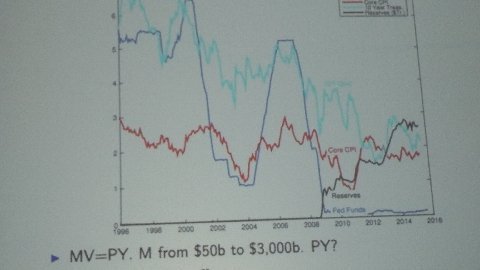Picto Diary - 20 October 2015 - Hoover Retreat (2)
Speaker Notes:

Above: Lanhee J. Chen. Hoover research scholar. Lecturer at Stanford Law School and Stanford Public Policy Program. Presidential appointee to the bipartisan and independent Social Security Advisory Board. Speaker Hoover Institution fall retreat. Stanford University, Palo Alto, CA. 20 October 2015.
Obamacare post 2016
Obamacare is bad policy, bad politics and bad law. Its not too late to change course.
Obama care themes:
1. One size fits all. Standardization of private plans. Guaranteed issue. Same rates. You can vary pricing only according to age. 65 plus = 3x payment. Essential benefits. 51 year old male pays for in vitro fertilization. Health insurance exchanges... most states have decided not to participate
2. Encouraging access to coverage. Government provided subsidies... employer mandates. Medicaid has experienced explosive growth. Standardized plans have not grown... too costly.
3. Align payments with performance. Pay for quality more than volume.
4. Finance program with "revenue enhancements and increased taxes. Idea was that program to be paid for by increased taxes and Medicare cuts.
Huge bureaucracy.
Law working? 15 million of 40 million covered... 11mm of which in Medicaid. Vast majority not signing up. Too expensive.
Medicaid not good insurance. Health outcomes same as uninsured.
Only 1MM new signers expected for 2016.
Nine of twenty three non profit insurance coops have failed.
Guaranteed backside government payment to insurance companies with losses... referred to as "risk corridor" in ACA legislation, is tantamount to a tax payer bailout.
Sign-ups:
| Year | Gov't Forecast (MM) | Actual (MM) |
| 2013 | 8.0 | 6.0 |
| 2014 | 5.0 | 3.1 |
| 2015 | 8.0 | 1.3 |
Little interest among higher income healthier Americans to sign up. Most who sign up are on government benefits.
GOP Plan
1. Full repeal Obamacare.
2. Must get cost down. One size fits all increases cost. Coverage will increase if there are more options. More choice.
3. Must temper reliance on government. States not Feds should regulate. People and needs differ from geography to geography.
4. Medicare and Medicaid are out of control. Migrate to more choice based plans.
5. More transparency on quality and cost
6. Pre-existing condition protections.
7. Expand use of Health Savings Accounts (HSA's).
Middle Ground.
1. Repeal mandates
2. Limit coverage subsidies
3. Repeal some taxes (Cadillac Tax)
4. Limit taxpayer bailouts (risk corridor).
5. Greater state flexibility on bailouts.

Above: Amy Zegart. Hoover Senior Fellow. Cyber threat expert. Political science professor at Stanford. Author: Spying Blind: The CIA, the FBI and the Origins of 9/11 and Flawed by Design: The Evolution of the CIA, JCS, and NSC. Speaker Hoover Institution fall retreat. Stanford University, Palo Alto, CA. 20 October 2015.
Cyber threats everywhere. Many breeches.
Threat environment is unprecedented. In cold war it was easy to identify the threat... today, its more complex.
Threat environment is crowded, uncertain and dynamic.
Major actors: Russia, China, ISIS, Anonymous...
Government alone cannot protect us. There is a "trust deficit" between government and private entities regarding cyber. 64% of Apple's customers are outside of the United States.
Cyber attacks growing.... no safe neighborhoods. The internet was designed to be open. 40% of the world population is connected to the internet.
Vulnerability is huge. In any 2500 lines of code there will be one weak line that can be penetrated. Kind of like the Jurassic Park velociraptors looking for the weak link in the fence.
In the next two weeks a "Hello Barbie" doll goes on the market that converses with child using cloud connected artificial intelligence to conform conversations to the child's questions and thought patterns. Can anyone imagine the potential for mind control of something like this if control were placed in the wrong hands?
Use of term cyber "attack" problematic. Words matter. Use of the term "attack" causes people to expect that it something that the government should deal with. Government way behind on dealing with problems. No mechanisms for enforcement... no protocols.
Is deterrence possible? Punishment may make problem worse. Cyber attackers go further "underground," become impossible to penetrate.
Counter hacks may be only way to let adversaries know that there is a cost.

Above: John H. Cochrane. Hoover Senior Fellow. Professor University of Chicago business school. Maintains The Grumpy Economist blog. Speaker Hoover Institution fall retreat. Stanford University, Palo Alto, CA. 20 October 2015.

Above: Graph key:
Red: Core inflation rate
Dark Blue: Fed funds rate
Black: Bank reserves
Turquoise: 10 year bond rate
Things may not be as bad as they look!
Declining 10 year bond rate... markets don't appear to be worrying about inflation. Also... there's nothing wrong with a 1% to 2% deflation should that occur. Japan endured such for nearly 16 years sans an economic vortex implosion.
Growing reserves (QE) from 2008? $50 billion to $3 trillion? QE seems to have had no visible effect on inflation rate or 10 year bond rate.
Economies can be stable when rates are near 0%. Argument for Fed doing nothing?
Fed has been trying to stoke inflation for 7 years. Japan tried for 20 years. Are the central banks really in charge as much as we think? I don't think the Fed can do that much. Raising rates may be the quintessential "head fake."
Good news... the US may be screwed up... but, the rest of the world is more screwed up!
There's plenty to worry about, notwithstanding... more and more Fed not rules based... flying on wing and a prayer. Check with John Taylor.

Above: David Brady. Senior Fellow Hoover Institution. Professor Stanford Business School and Political Science professor Stanford. He is currently working on a book on the electoral base of party parity in the United States and its effects on polarization and gridlock in the policy arena. Speaker Hoover Institution fall retreat. Stanford University, Palo Alto, CA. 20 October 2015.
Party memberships more or less at parity. 1/3 (Dem), 1/3 (Pub), 1/3 (Ind). Highest rate of independents in electoral history.
Independents. Swing voters who will decide elections. Have been leaning Pub recently.
Because of electoral college, Dems have the advantage. Pubs have never won the presidency sans capturing Ohio, Florida, and Virginia.
In Congress elections... Pubs have the advantage. House may lose 4 or five seats. There is a 60% chance that Senate will remain Pub in 2016 (provided low turnout election, which is likely).
Our polling. We talk to 1500 people once a month
Trump supporters: Less well educated, older, more liberal and anti-immigration. His support mirrors somewhat what is going on in Europe... the National Front, in France, for example. Marine LePen.
The three non-politician candidates (Trump, Carson, Fiorina) will fade... just as Bachman and Cain did last time around... though Fiorina likely to be Rubio's VP candidate, for obvious reasons.
HRC was doing poorly until the recent GOP circular firing squad started eg. Kevin McCarthy's candidacy, then, un candidacy for the Speaker job... and his gaff labeling the Benghazi hearings as political. Still, she's not in great shape. She's been pushed further to the left by Sanders and if Biden comes in, that gives her a bit more trouble. The Dems have been casting off the email issue as irrelevant. However 72% of independents consider it "an issue."

Above: Mary Lou and TIMDT. Hoover Institution dinner, 19 October 2015, McCaw Hall. Stanford University. 19 October 2015.
Hello Mary Lou.... Goodbye heart!

Above: Paul, TIMDT, Cousine (sic) Sarah, and Mwah (sic). Menlo Grill. Menlo Park, CA. 20 October 2015.
Sarah is Aunt Joyce's youngest (of two) daughter. Sarah and Paul have four great kids out of the nest... two daughters are married. Their first grandchild on the way! Paul is retired tech... worked for Apple, among others. Sarah is an elementary school librarian working for the Palo Alto, CA school district.
Addendum:

Above: Sent by John Galt. Photographed from his Piper Cub while flying someplace over eastern Washington.
The Hoover Institution is "on message." What else would you expect to hear from them? You could have saved the effort and waxed skis instead.
Thanks for sharing, in any case.
Best regards,
FeeNix,
Phoenix, AZ
Great notes,Steve. You are very talented. Great seeing Margaret,too. All the best!
Stagecoach,
San Francisco, CA
Sounds like the kind of place that BSSS would go to seek what he thinks is enlightenment.
It’s what you get when you are mostly concerned with the vessel rather than its contents….
Jack Aroon,
Mahwah, NJ
Daily Report: A Scandal at Stanford University
By
Pui-Wing Tam
October 21, 2015 9:27 am
Stanford University has long been a bedrock part of Silicon Valley, feeding talent and ideas to the tech industry. But its business school has recently been engulfed in a well-chronicled scandal that led to the resignation of the school’s dean last month, and now David Streitfeld finds that the hubbub has revealed issues at another part of Stanford, the Hoover Institution.
The business school and Hoover incidents both involve management issues with women. They come against a backdrop where Silicon Valley has been debating — and flagellating itself — for the lack of gender diversity in tech.
Over the past few years, Silicon Valley technology companies have reported data on the diversity of their workforce. The numbers have shown the lack of women in technology roles and little progress has been achieved in closing the gap.
Add to that a number of other episodes at Silicon Valley firms where the role of women has been spotlighted, including Ellen Pao’s high-profile suit for gender discrimination against her former employer, venture capital firm Kleiner Perkins Caufield & Byers. While Ms. Pao’s claims were rejected by a jury, the trial over the suit gave a peek into the old boys’ behavior that can permeate Silicon Valley.
The issues at Hoover and Stanford’s business school may now play into the same debate.
http://bits.blogs.nytimes.com/2015/10/21/daily-report-a-scandal-at-stanford-university/?_r=0
The uproar over the business school’s situation, in turn, led several sources, including a research fellow at Hoover, to approach The New York Times about complaints at the Hoover Institution. In early 2013, some women at Hoover, a conservative-leaning policy center, began to express dissatisfaction more widely about the work environment, saying it was a place where men hired their male friends and women were marginalized.
The university began an investigation that took several months. Women in one department at Hoover “felt the work environment has been threatening at times,” while the majority of female interviewees said it was “not always a ‘respectful’ workplace,” according to Stanford’s “summary of findings” of the investigation, copies of which were reviewed by The New York Times.
John Etchemendy, Stanford’s provost, would not discuss the claims about the business school and Hoover in detail. He said that Stanford had hired separate outside investigators and that neither had found systemic discrimination. But he acknowledged “weaknesses in management” and said they were being addressed.